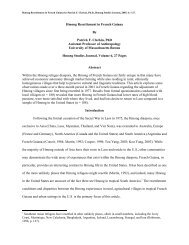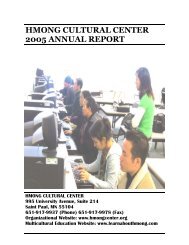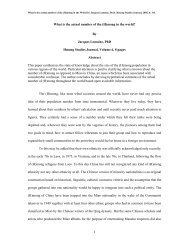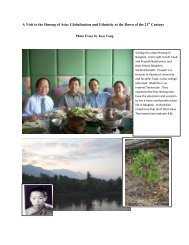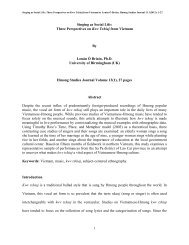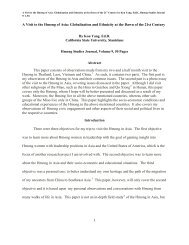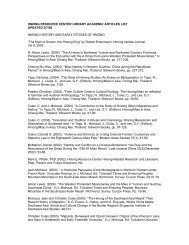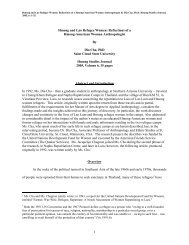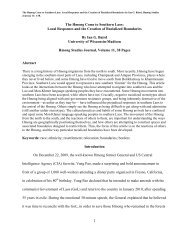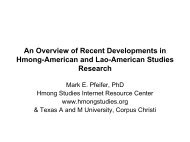Research Notes from the Field - Hmong Studies Internet Resource ...
Research Notes from the Field - Hmong Studies Internet Resource ...
Research Notes from the Field - Hmong Studies Internet Resource ...
You also want an ePaper? Increase the reach of your titles
YUMPU automatically turns print PDFs into web optimized ePapers that Google loves.
<strong>Research</strong> <strong>Notes</strong> <strong>from</strong> <strong>the</strong> <strong>Field</strong>:Tracing <strong>the</strong> Path of <strong>the</strong> Ancestors – A Visit to <strong>the</strong> <strong>Hmong</strong> in China by Kou Yang, EdD,<br />
<strong>Hmong</strong> <strong>Studies</strong> Journal, 2005, 6: 1-38.<br />
promoted equality and equity among all ethnic groups. Although things were not perfect under <strong>the</strong><br />
Communists, <strong>the</strong> socio-economic and political situations of <strong>the</strong> Miao appeared to be better in many ways.<br />
With <strong>the</strong> Communist party in power, Qiandongnan, for example, was proclaimed Miao and Dong<br />
Autonomous Prefecture. Minorities were also given some decision making power. Moreover, for <strong>the</strong> first<br />
time in Guizhou history, a Miao reached <strong>the</strong> rank of Provincial Governor in 1997. Wang Chaowen, who was<br />
born in Huangping County, Qiangdongnan Prefecture, served one term as Governor of Guizhou and so far<br />
has <strong>the</strong> reputation of being one of <strong>the</strong> most effective Governors of <strong>the</strong> province. Guizhou continues to<br />
include many minorities in its current government. Wang Zhengfu, <strong>the</strong> current Executive Vice-Governor of<br />
Guizhou Province, for example, is Miao of <strong>the</strong> Hmu group, and a native of Kaili.<br />
Minority Policy Under <strong>the</strong> Red Flag of <strong>the</strong> People’s Republic of China<br />
During <strong>the</strong> many lectures on Chinese history and <strong>the</strong> experience of <strong>the</strong> minorities in China, this<br />
author ga<strong>the</strong>red that <strong>the</strong> minorities and peasants in Guizhou supported <strong>the</strong> Chinese Communist movement in<br />
<strong>the</strong> early twentieth century because of <strong>the</strong>ir poverty, <strong>the</strong> Long March, and <strong>the</strong> Communists’ stated policies of<br />
equality for all <strong>the</strong> people of China. During <strong>the</strong> Long March, which took place in <strong>the</strong> 1930s, Mao Zedong and<br />
his red army passed through many Miao villages in Guizhou and found <strong>the</strong> Miao to be very poor, but friendly.<br />
Mao Zedong instructed his troops to be culturally sensitive to <strong>the</strong> minority people and <strong>the</strong> peasants. As a<br />
result of <strong>the</strong>ir poverty and Mao’s respect and sympathy toward <strong>the</strong>m, many Miao villagers and leaders began<br />
to support <strong>the</strong> Communist movement. When <strong>the</strong> Communists took power in 1949, <strong>the</strong>y brought many<br />
minorities and peasants into <strong>the</strong> government of <strong>the</strong> People’s Republic and declared many regions, prefectures,<br />
and counties as minority autonomous regions. The Miao and o<strong>the</strong>r minorities enjoyed a short period of<br />
protection and inclusion <strong>from</strong> <strong>the</strong> Chinese Communist Party and government. The Cultural Revolution, which<br />
was started in 1966 by Mao Zedong to eliminate his political rivals, negatively impacted <strong>the</strong> Chinese minority<br />
policy and associated minority cultural protections. The Cultural Revolution promoted <strong>the</strong> destruction of <strong>the</strong><br />
“Four Olds,” including cultural practices, religious places and symbols, and anything that was considered a<br />
remnant of <strong>the</strong> past system. Minority religion, festivals and traditions were forbidden.<br />
The visit of US President Richard Nixon to China in 1972, and <strong>the</strong> arrest of <strong>the</strong> so-called Gang of<br />
Four in 1976 marked <strong>the</strong> beginning of China’s open door policy. After <strong>the</strong> opening of China to <strong>the</strong> west,<br />
many Chinese Government officials, scholars, and students were sent to <strong>the</strong> west to study and go on<br />
educational tours of o<strong>the</strong>r countries. Many of <strong>the</strong>se officials brought <strong>the</strong>ir knowledge about foreign laws and<br />
policies about protecting <strong>the</strong> rights of minorities and promoting tolerance to China. These visits and <strong>the</strong><br />
22




